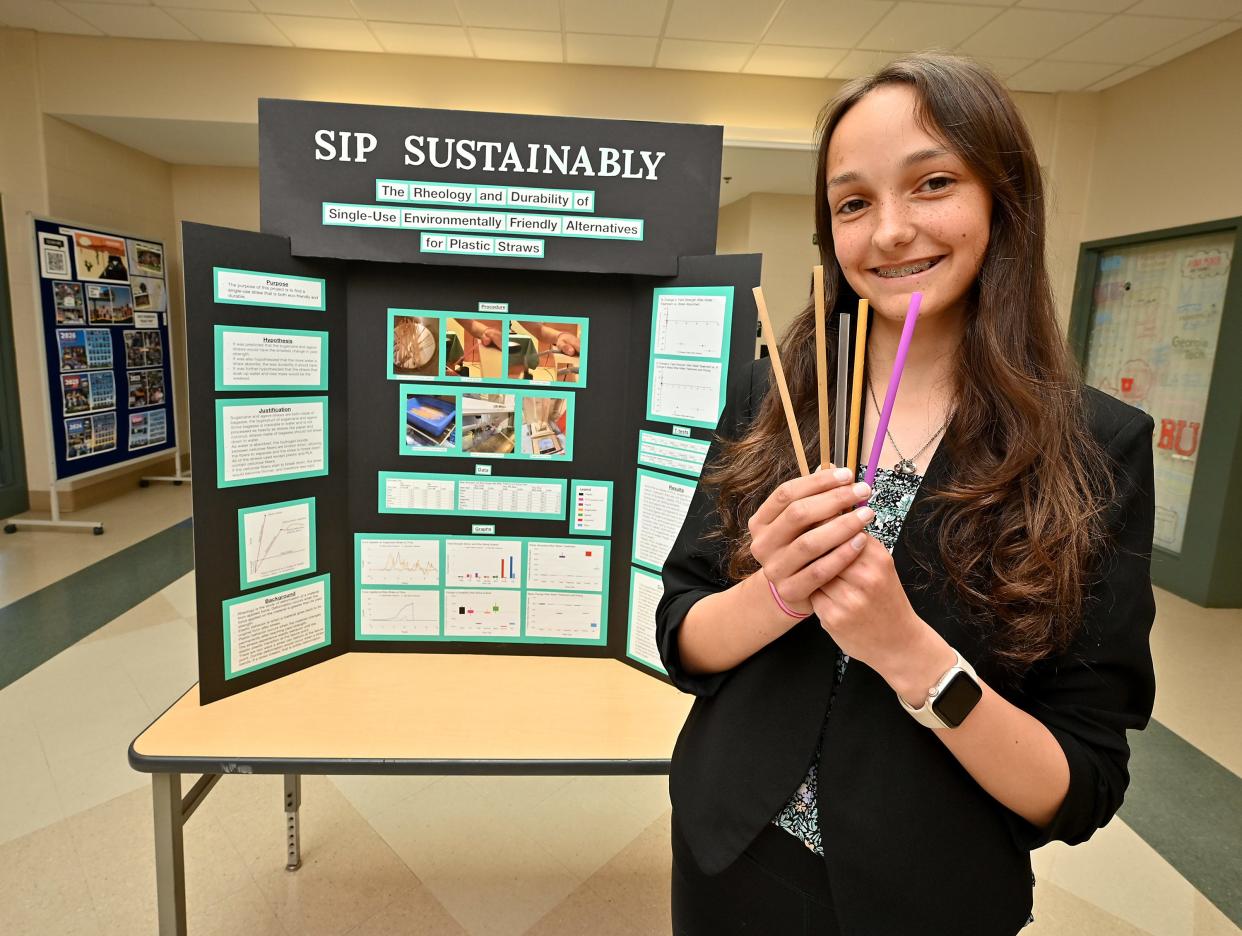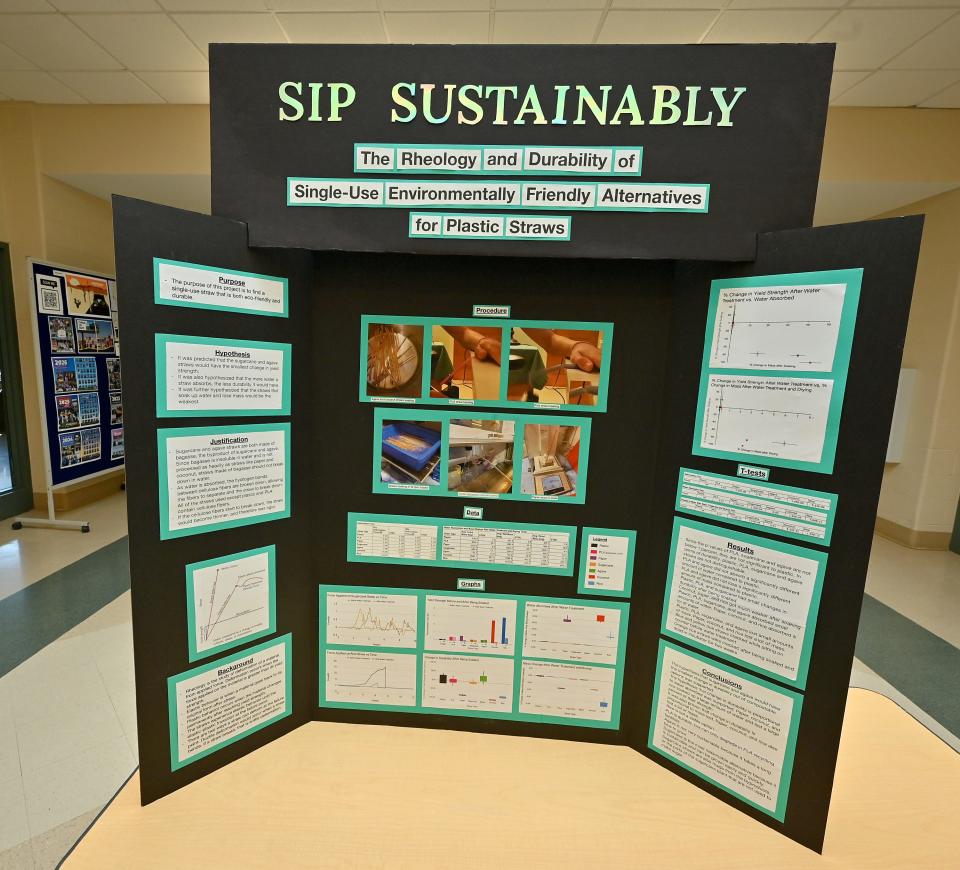Wachusett Regional freshman places 1st at State Science Fair

HOLDEN — Sierra Kelch has a recommendation: If you’re looking for a durable alternative to plastic straws, try straws made out of sugarcane or agave.
The first-year Wachusett Regional High School student recently took the top prize at the Massachusetts Science and Engineering Fair for her experiment looking at which plastic straw alternatives not only stood the best chances of soaking in ice water for an hour without falling apart but were also best for the environment.
“It was incredible to win the grand prize as a freshman,” Kelch said. “It’s amazing to get all of this recognition for my hard work.”
She won the Sanofi Grand Prize, that included a cash prize of $10,000 for herself, as well as $7,500 for the school’s science department and $2,500 for her honor physics teacher, Eric Chandonnet.

Although the majority of her life has been spent in Massachusetts, Kelch was born in San Francisco. And it was during a trip to her birth state that she found the question she wanted to answer for her science fair project.
“Plastic straws are banned there, and I used a lot of paper straws and a lot of them broke down in my drink,” she said. “They were very frustrating, so I thought, ‘Well, when plastic straw bans come to Massachusetts, what will we do? What will be the next plastic straw alternative that breaks down in the environment, but not in the drink?’ “
In the Wachusett Regional School District, every student who is taking an honors science course must complete a yearlong independent science project.
But the project is different from writing a traditional report or "your classic middle school volcano" in that it must involve formulating a hypothesis on a topic and actively designing an experiment to test their hypothesis and then statistically analyze their data to come to conclusions, said Nicholas Guerin, a chemistry teacher at the high school and science fair adviser.
After her trip, Kelch said wanted to see which alternative straw materials available on the market would make it through the average length of a meal.
Looking to Amazon, she bought and tested the durability of polylactic straws, as well as biodegradable straws made out of paper, sugarcane, agave, coconut and rice compared to traditional plastic straws, which she used as her control.

While she worked with Chandonnet throughout her project, being able to come to him for advice and guidance and finding solace in his classroom, Kelch largely came up with ideas about how to conduct experiments during her free time.
Data and research next
Her weekends, as well as winter break, were spent collecting and analyzing data, and conducting research.
It was during these times that Kelch began setting the parameters of her experiment, and discovering things like the average length of a meal, or that she wanted to test the straws in ice water because it would relatively stay at the same temperature the entire time.
"I tested their durability by measuring the force needed for these straws to fail or bend, and I measured that before and after being soaked," she said. "I also measured the amount of water that the straws absorbed and how much of a straw fell off while it was being soaked and broke down into the water."
It was details like this that helped Kelch’s project stand out, because “even though it was simple, it was carried out with great detail and also helped solve a bigger real-world problem,” Guerin said.
“Out of the compostable straws, the sugarcane and agave straws were the most durable,” she said. “They did not have large changes in durability before and after being soaked. They also did not absorb much water and then they did not break down much.”
While PLA straws are comparable to traditional plastic straws, as well as being biodegradable, Kelch said consumers still need to be careful when using them.
They can only be recycled in special facilities, she said, and can mess up “entire batches” of recycling if mixed in, so consumers should be aware of that when using them.
Use any alternative to plastic
Although it can be difficult to recycle PLA straws, and she would recommend the sugarcane or agave straws as the alternative, Kelch said she recommends people use any alternative available to them “whenever you can” over plastic.
“Sustainability matters and this is our world,” Kelch said. “Plastic straws are one of the most used plastic items, so be careful when you're using them.”
Kelch said that she had set her sights on at least placing at the school science fair, and that she did not expect to take the top prize at the state science fair “at all.”
And the odds would typically be stacked against her, Chandonnet said.
“Making the state science fair as a freshman is almost unheard of,” he said. “Because you're competing against sophomores and juniors and seniors who have three years of science background.”
This year, Wachusett had 42 students compete in the school fair, which was down from about 75 from before the COVID-19 pandemic, Guerin said.
From there, the top 12 projects went on to the regional fair in early March at Worcester Polytechnic Institute, which had about 90 projects and 115 students competing overall.
Final fair at MIT
The top 40% of those projects were sent to the State Science Fair, which took place at Massachusetts Institute of Technology last week, and had nearly 260 projects and 300 students being judged, Guerin said.
After five judges, who all have some type of science background, watched as students presented their projects and gave out scores, Kelch’s was the highest.
When she found out she received the top prize, Kelch said she was speechless.
“I still can't believe that I won the entire thing. It's incredible,” she said.
Chandonnet said that when Kelch called him with the news, he was “blown away,” and started tearing up.
“Seeing her just constantly work through and learn new things and build her scientific knowledge and her experimentation skills, it was just awesome to see a student put it all together and do high-level research and experimentation,” he said.
Other Wachusett students awarded at fair
Kelch was not alone though, as five other students at the high school placed at the State Science Fair as well:
Second-Place Awards — Verena Welch, Ekaavli Daga and Jocelyn MacDonough
Third-Place Awards — Nathaniel Dziewietin and Nikhita Varma
Chandonnet said it was "nice to see" his former students do well in placing at the State Science Fair.
"I like to say that in freshman year, we sort of plant the seed of the science experimentation in these kids with honors physics, and then they really sort of blossom and bloom sophomore, junior year," he said.
In addition to the cash prize, Kelch also won an internship at Sanofi, a company that makes vaccines and pharmaceuticals and an award sponsor, as well as a scholarship to the Harvard Summer Secondary School.
She said the details of the internship are still being worked out, but that she thinks it will start this summer.
While she still has quite a bit of time left to figure it out, the internship will be a good experience, Kelch said, since she wants to work in the medical sciences someday. And her grand prize is going to help her get there by going toward her college fund.
But what is also important, she said, is that people know “science is for everyone.”
“I'm a freshman, I haven't taken a lot of higher-level science courses, and I was able to get this far,” she said. “You don't need to have a lot of fancy equipment or a lot of science background. You just need a question that you are very curious about and passionate about, and if you dedicate yourself to your project, you will do very well.”
There were other students from the Central Massachusetts region that were top winners. The name of those students, their school, and prize are listed below:
Caden Ashmore, Grafton High School, won the National Grid Engineering Excellence Award and a first place award and also received a Worcester Polytechnic Institute scholarship
Maya Sushkin, South High Community School, won the Eversource Sustainability Award
Joseph Yu, Massachusetts Academy for Math and Science, won the Regeneron Biomedical Sciences Award
Aryan Mago, who is from Shrewsbury but attends Groton School, and Kenerson Cronin, Bancroft School, each won an awrd from the Upton-based Mass. Chemistry and Technology Alliance
Isha Nagireddy, Shrewsbury High School, won the ALKU Foundation Award for impact on community or social-emotional well-being and she won a first place award
Anika Kale, Westborough High School, won the American Society of Safety Professionals Award
Sophie Chiang, St. Mark’s School in Southborough, won the Pauline J. LaMarche Award for a project that displays excellence in design and implementation and also won a first place award
Esther Xu, Belmont High School, won the Hologic Award from the Marlborough-based medical technology company Hologic, Inc.
Shuhan Luo of Worcester/Worcester Academy and Krisha Patel of the Massachusetts Academy for Math and Science each received first place awards
This article originally appeared on Telegram & Gazette: Wachusett Regional's Sierra Kelch places 1st at State Science Fair

